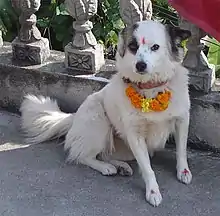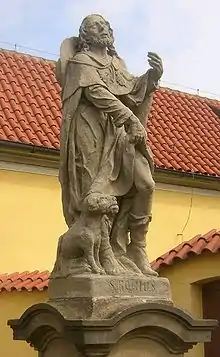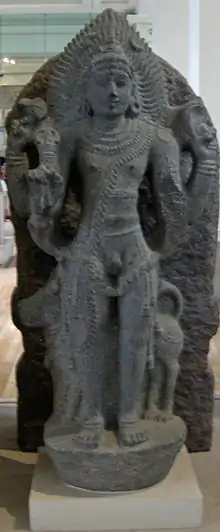Dogs in religion
Dogs (Canis lupus familiaris), which are humanity's first and most-common domestic animals, have played a role in many religious traditions.

Religions and cultures
Below entries are arranged in alphabetical order.
Aztec religion
Dogs had a major religious and symbolic significance to the Aztec peoples of central Mexico. Several ancient burial sites for dogs have been discovered in Mexico.[1] Xolotl, an Aztec god of death, was depicted as a dog-headed monster.
Chinese tradition
The dog is one of the 12 animals honoured in Chinese astrology. The second day of the Chinese New Year is considered to be the birthday of all dogs and Chinese people often take care to be kind to dogs on that day.
Panhu is a dragon-dog who transformed into a man and married a princess.
Christianity

A dog is mentioned in the deuterocanonical Book of Tobit, faithfully accompanying Tobias, Tobit's son and the angel Raphael on their journeys.
Jesus told the story of the poor man Lazarus, whose sores were licked by street dogs. This has traditionally been seen as showing Lazarus's wretched situation.
The Roman Catholic Church recognizes Saint Roch (also called Saint Rocco), who lived in the early 14th century in France, as the patron saint of dogs. It is said that he caught the plague while doing charitable work and went into the forest, expecting to die. There he was befriended by a dog that licked his sores and brought him food, and he was able to recover. The feast day of Saint Roch, August 16, is celebrated in Bolivia as the "birthday of all dogs."[2]
Saint Guinefort was the name given to a dog who received local veneration as a saint at a French shrine from the 13th to the 20th centuries.[3]
A black and white dog is sometimes used as an informal symbol of the Dominican order of friars, religious sisters and nuns. This stems from a Latin pun: though the order's name is actually the Friars Preachers (Ordus Praedicatorum – order of preachers), it is generally called the Dominicans (after St. Dominic, their founder): Domini canes in Latin means "the dogs/hounds of the Lord."
Ancient Egyptian religion
The Ancient Egyptians are often more associated with cats in the form of Bastet, yet here too, dogs are found to have a sacred role and figure as an important symbol in religious iconography.[4]
Dogs were associated with Anubis, the jackal headed god of the underworld. At times throughout its period of being in use the Anubieion catacombs at Saqqara saw the burial of dogs.[5] Anput was the female counterpart of her husband, Anubis, she was often depicted as a pregnant or nursing jackal, or as a jackal wielding knives.
Other dogs can be found in Egyptian mythology. Am-heh was a minor god from the underworld. He was depicted as a man with the head of a hunting dog who lived in a lake of fire. Duamutef was originally represented as a man wrapped in mummy bandages. From the New Kingdom onwards, he is shown with the head of a jackal. Wepwawet was depicted as a wolf or a jackal, or as a man with the head of a wolf or a jackal. Even when considered a jackal, Wepwawet usually was shown with grey, or white fur, reflecting his lupine origins. Khenti-Amentiu was depicted as a jackal-headed deity at Abydos in Upper Egypt, who stood guard over the city of the dead.
Greek mythology
Dogs were closely associated with Hecate in the Classical world. Dogs were sacred to Artemis and Ares. Cerberus was the three-faced guard dog of the Underworld. Laelaps was a dog in Greek mythology. When Zeus was a baby, a dog, known only as the "golden hound" was charged with protecting the future King of Gods.[6]
Hinduism

The dog (Shvan) is also the vahana or mount of the Hindu god Bhairava. Yudhishthira had approached heaven with his dog,[7] therefore among many Hindus, the common belief exists that caring for or adopting dogs can also pave the way to heaven. Dogs are also shown in the background in the iconography of Hindu deities like Dattatreya, many times dogs are also shown in the background in the iconography of deities like Khandoba.
Islam
The majority of both Sunni and Shi'a Muslim jurists consider dogs to be ritually unclean.[8] It is uncommon for practicing Muslims to have dogs as pets.[9] However, the majority of Muslims would touch and pet dogs if they are in no form wet to the touch as that is considered to bring out the impurities of the dog. In Britain, police sniffer dogs are carefully used, and are not permitted to contact passengers, only their luggage. They are required to wear leather dog booties when searching mosques or Muslim homes.[10]
There are a number of traditions concerning Muhammad's attitude towards dogs. He said that the company of dogs, except as helpers in hunting, herding, and home protection, voided a portion of a Muslim's good deeds.[11] On the other hand, he advocated kindness to dogs and other animals.[12][13] Abu Huraira narrated that the prophet said:
"While a man was walking he felt thirsty and went down a well, and drank water from it. On coming out of it, he saw a dog panting and eating mud because of excessive thirst. The man said, 'This (dog) is suffering from the same problem as that of mine.' So, he (went down the well), filled his shoe with water, caught hold of it with his teeth, and climbed up and watered the dog. Allah thanked him for his (good) deed and forgave him. The people asked ``O Allah's Apostle! Is there a reward for us in serving (the) animals? He replied: ``Yes, there is a reward for serving any animate (living being).[13]
Judaism
In Judaism, there is no explicit ban on keeping dogs, and although the opinion about dogs varies among Jews, dogs are mostly portrayed negatively in both the Hebrew Bible and the Talmud, where they are mostly associated with violence and uncleanliness. Deuteronomy 23:19 appears to equate dogs to prostitution, and the Book of Kings describes dogs who feed on corpses. The Psalms describes dogs as beasts that maul at human beings.
This negative view of dogs is also found in the Talmud, which also describes dogs as dangerous animals. However, dogs and other animals that are useful for preventing infestations of vermin are permissible for use as long as they are chained, although those who raise a dog are cursed.[14]
The Misneh Torah states that dogs must be chained since they are known to cause frequent damage. The Shulchan Aruch states that only evil dogs must be bound and chained. Most Jewish authorities believe that there are no prohibitions on keeping dogs if they pose no threat to people or property.
Judaism does not permit neglect and abuse of any living animal. The Jewish law states that any animal that is kept must be fed and that arrangements for feeding them must be made before obtaining them. This ruling applies to dogs as well.[15]
In July 2019, Rabbis from Elad signed an edict to ban dogs from the city. The rabbis say in the edict that the dogs are scaring women and children with their barks, “even if it does not bite”. They also refer to Torah and Talmud passages to motivate their plans.[16]
Mesopotamia
There is a temple in Isin, Mesopotamia, named é-ur-gi7-ra which translates as "dog house".[17] Enlilbani, a king from the Old Babylonian First Dynasty of Isin, commemorated the temple to the goddess Ninisina.[18] Although there is a small amount of detail known about it, there is enough information to confirm that a dog cult did exist in this area.[19] Usually, dogs were only associated with the Gula cult, but there is some information, like Enlilbani's commemoration, to suggest that dogs were also important to the cult of Ninisina, as Gula was another goddess who was closely associated to Ninisina.[20] More than 30 dog burials, numerous dog sculptures, and dog drawings were discovered when the area around this Ninisina temple was excavated. In the Gula cult, the dog was used in oaths and was sometimes referred to as a divinity.
Philistines
At archaeological diggings at the Philistine city of Ashkelon, a very large dog cemetery was discovered in the layer dating from when the city was part of the Persian Empire. It is believed the dogs may have had a sacred role – however, evidence for this is not conclusive.
Zoroastrianism
In Zoroastrianism, the dog is regarded as an especially beneficent, clean and righteous creature, which must be fed and taken care of.[21] The dog is praised for the useful work it performs in the household,[22] but it is also seen as having special spiritual virtues. A dog's gaze is considered to be purifying and to drive off daevas (demons). It is also believed to have a special connection with the afterlife: the Chinwad Bridge to Heaven is said to be guarded by dogs in Zoroastrian scripture,[22] and dogs are traditionally fed in commemoration of the dead.[23] Ihtiram-i sag, "respect for the dog", is a common injunction among Iranian Zoroastrian villagers.[21]
Detailed prescriptions for the appropriate treatment of dogs are found in the Vendidad (a subdivision of the Zoroastrian holy scripture Avesta), especially in chapters 13, 14 and 15, where harsh punishments are imposed for harm inflicted upon a dog and the faithful are required to assist dogs, both domestic and stray, in various ways; often, help or harm to a dog is equated with help and harm to a human.[24] The killing of a dog ("a shepherd's dog, or a house-dog, or a Vohunazga [i.e. stray] dog, or a trained dog") is considered to lead to damnation in the afterlife.[24] A homeowner is required to take care of a pregnant dog that lies near his home at least until the puppies are born (and in some cases until the puppies are old enough to take care of themselves, namely six months). If the homeowner does not help the dog and the puppies come to harm as a result, "he shall pay for it the penalty for wilful murder", because "Atar (Fire), the son of Ahura Mazda, watches as well (over a pregnant dog) as he does over a woman".[25] It is also a major sin if a man harms a dog by giving it bones that are too hard and become stuck in its throat, or food that is too hot, so that it burns its throat.[26] Giving bad food to a dog is as bad as serving bad food to a human.[27] The believers are required to take care of a dog with a damaged sense of smell, to try to heal it "in the same manner as they would do for one of the faithful" and, if they fail, to tie it lest it should fall into a hole or a body of water and be harmed.[22]
Both according to the Vendidad and in traditional Zoroastrian practice, dogs are allotted some funerary ceremonies analogous to those of humans.[23] In the Vendidad, it is stated that the spirits of a thousand deceased dogs are reincarnated in a single otter ("water dog"), hence the killing of an otter is a terrible crime that brings drought and famine upon the land and must be atoned either by the death of the killer[22] or by the killer performing a very long list of deeds considered pious, including the healing of dogs, raising of puppies, paying of fines to priests, as well as killing of animals considered noxious and unholy (cats, rats, mice and various species of reptiles, amphibians, and insects).[28]
Sagdid is a funeral ceremony in which a dog is brought into the room where the body is lying so that it can look on it. "Sagdid" means "dog sight" in the Middle Persian language of Zoroastrian theological works. There are various spiritual benefits thought to be obtained by the ceremony. It is believed that the original purpose was to make certain that the person was really dead since the dog's more acute senses would be able to detect signs of life that a human might miss. A "four-eyed" dog, that is one with two spots on its forehead, is preferred for sagdid.[29][30]
The traditional rites involving dogs have been under attack by reformist Zoroastrians since the mid-19th century, and they had abandoned them completely by the late 20th century. Even traditionalist Zoroastrians tend to restrict such rites to a significant extent nowadays (late 20th – early 21st century).[23]
See also
- All Dogs Go to Heaven
- The Hound of the Baskervilles
- Amarok/Amaguq (Inuit mythology)
- Anubis
- Barghest (Yorkshire)
- Black dog (ghost) (Britain)
- Black Shuck (East Anglia)
- Cerberus
- Chinese guardian liondogs
- Church Grim (England)
- Coyote (mythology) Coyote (Navajo mythology)
- The dingo in Aboriginal folklore and mythology
- Dip (Catalonia)
- Dog (zodiac)
- Dog in Chinese mythology
- Dogs in warfare
- Gwyllgi (Wales)
- Gytrash (Northern England)
- Hellhound
- Hound of Culann
- Inugami
- Yama-Inu (also see the Japanese wolf).
- Moddey Dhoo (Mauthe Doog) (Manx)
- The dogs of war (phrase)
- Tokugawa Tsunayoshi (the "Dog Shōgun")
- Wolves in folklore, religion and mythology
References
- Olga R. Rodriguez (February 14, 2014). "Aztec dog burial site found in Mexico City". Associated Press.
- Webmaster (webmaster@culturalcatholic.com). "Cultural Catholic – Saint Roch (Saint Rocco)". culturalcatholic.com. Retrieved May 12, 2015.
- Stephen de Bourbon (died 1262): De Supersticione
- Frankfort, H. (2011). Ancient Egyptian Religion: An Interpretation. Dover Publications. p. 9. ISBN 9780486411385. Retrieved May 12, 2015.
- Bard, K.A. (1999). Encyclopedia of the Archaeology of Ancient Egypt. Taylor & Francis. ISBN 9780203982839. Retrieved May 12, 2015.
- http://www.sheppardsoftware.com/content/animals/animals/breeds/dogtopics/dog_mythology.htm
- Textual Sources for the Study of Hinduism, p. 53, by Wendy Doniger, publisher = Manchester University Press
- Encyclopedia of Religion and Nature, s.v. "Dogs in the Islamic Tradition and Nature." New York: Continuum International, forthcoming 2004. By: Dr. Khaled Abou El Fadl
- Susan J. Armstrong, Richard G. Botzler, The Animal Ethics Reader, p.237, Routledge (UK) Press
- Steve Dale (March 2, 2015). "Muslims Object to Dogs". ChicagoNow. Archived from the original on June 20, 2015.
- Malik ibn Anas, al-Muwatta (Egypt: al-Babi al-Halabi, n.d.), 2:969. Reported in El Fadl
- Abu Huraira Volume 3, Book 40, Number 551.
- https://quranx.com/Hadith/Bukhari/USC-MSA/Volume-3/Book-40/Hadith-551 Compendium of Muslim Texts – Abu Huraira, Volume 3, Book 40, Number 551
- https://www.myjewishlearning.com/article/judaism-dogs/
- https://www.jewishvirtuallibrary.org/judaism-and-the-treatment-of-animals
- https://www.thejc.com/news/israel/hounds-from-hell-rabbis-sign-anti-dog-edict-1.486441
- Livingstone, A (1988). "The Isin “Dog House” Revisited", Journal of Cuneiform Studies, 40 (1), p54
- Shaffer, Aaron (1974). "Enlilbaniand the ‘DogHouse’ in Isin", Journal of Cuneiform Studies, 26(4) p. 251-252)
- Livingstone ibid, 1988, p. 58
- Shaffer, Aaron (1974) Ibid, p. 253
- Boyce, Mary 1989. A History of Zoroastrianism: The Early Period. P.303
- Joseph H. Peterson. "AVESTA: VENDIDAD (English): Fargard 13". avesta.org. Retrieved May 12, 2015.
- Encyclopaedia Iranica:Dog. In Zoroastrianism. By Mary Boyce.
- Joseph H. Peterson. "AVESTA: VENDIDAD: Table of Contents". avesta.org. Retrieved May 12, 2015.
- Vendidad, Fargard 15, passim, e.g. 21.
- Vendidad, Fargard 15, 2–4.
- http://www.avesta.org/vendidad/vd15sbe.htm Vendidad, Fargard 13, 20–28
- Joseph H. Peterson. "AVESTA: VENDIDAD (English): Fargard 14". avesta.org. Retrieved May 12, 2015.
- Jivanji Jamshedji Modi, 1928, The Funeral Ceremonies of the Parsees, Anthropological Society of Bombay
- The Zoroastrian Faith: Tradition and Modern Research, by Solomon Alexander Nigosian, Published by McGill-Queen's Press – MQUP, 1993, ISBN 0-7735-1144-X, 9780773511446 page 102 (page can be viewed via Google books)